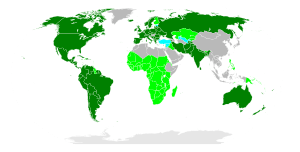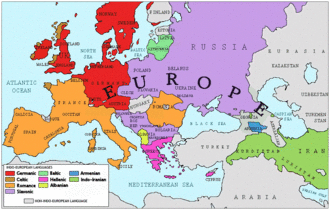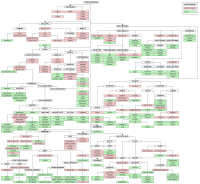Indo-European languages facts for kids
Quick facts for kids Indo-European |
|
|---|---|
| Geographic distribution: |
Before the 16th century, Europe, and South, Central and Southwest Asia; today worldwide. |
| Linguistic classification: | One of the world's major language families |
| Proto-language: | Proto-Indo-European |
| Subdivisions: |
Anatolian (extinct)
Tocharian (extinct)
|
| ISO 639-2 and 639-5: | ine |
 Countries with a majority of speakers of IE languages
Countries with an IE minority language with official status Countries where no Indo-European language is official, but a significant minority speak an Indo-European language |
|
The Indo-European languages are the world's largest language family.
Linguists believe they all came from a single language, Proto-Indo-European, which was originally spoken somewhere in Eurasia. They are now spoken all over the world.
The Indo-European languages are a family of several hundred related languages and dialects, including most major languages in Europe, the Iranian plateau, and South Asia.
Historically, this language family was also important in Anatolia and Central Asia.
The earliest Indo-European writing is from the Bronze Age in Anatolian and Mycenaean Greek. The origin of Indo-European is after the invention of farming since some Proto-Indo-European words are farming words.
Although it may have fewer different languages than some other language families, it has the most native speakers, about 2.7 billion.
Of the 20 languages with the most speakers, 12 are Indo-European: English, Spanish, Hindi, Portuguese, Bengali, Russian, German, Sindhi, Punjabi, Marathi, French, and Urdu.
Four of the six official languages of the United Nations are Indo-European: English, Spanish, French, and Russian.
Main language groups
These are the main Indo-European language groups:
- Albanian
- Anatolian: Luwian; Hittite
- Armenian
- Balto-Slavic
- Celtic (such as Irish and Welsh)
- Germanic (such as English, German, and Swedish)
- Greek (and modern Greek)
- Indo-Iranian
- Indo-Aryan languages (Indic)
- Iranian
- Latin and the Romance languages (such as French, Italian, and Romanian)
Most Indo-European languages use the Latin script, but others use the Devanagari, Cyrillic, or Arabic scripts.
Summary
- Further information: List of countries by spoken languages, Lists of languages, and List of languages by number of native speakers
The number of speakers derived from statistics or estimates (2019) and were rounded:
| Number | Branch | Languages | Native Speakers | Main Writing Systems | Ref |
|---|---|---|---|---|---|
| 1 | Albanian language | 4 | 7,500,000 | Latin | |
| 2 | Armenian language | 2 | 7,000,000 | Armenian | |
| 3 | Balto-Slavic languages | 25 | 270,000,000 | Cyrillic, Latin | |
| 4 | Celtic languages | 6 | 1,000,000 | Latin | |
| 5 | Germanic languages | 47 | 550,000,000 | Latin | |
| 6 | Hellenic languages | 6 | 15,000,000 | Greek | |
| 7 | Indo-Iranian languages | 314 | 1,650,000,000 | Devanagari, Perso-Arabic | |
| 8 | Italic languages | 44 | 800,000,000 | Latin | |
| Total | Indo-European languages | 448 | 3,300,000,000 | – |
History of Indo-European linguistics
Suggestions of similarities between Indian and European languages began to be made by European visitors to India in the 16th century. In 1583, Thomas Stephens S.J. an English Jesuit missionary in Goa, India, noticed similarities between Indian languages and Greek and Latin and included them included in a letter to his brother, but it was not published until the 20th century.
The first account to mention Sanskrit is from Filippo Sassetti. Born in Florence, Italy, in 1540, he was a merchant who was among the first Europeans to study the Sanskrit. Writing in 1585, he noted some word similarities between Sanskrit and Italian such as devaḥ/dio "God", sarpaḥ/serpe "serpent", sapta/sette "seven", aṣṭa/otto "eight", nava/nove "nine"). However, neither observation led to further scholarly inquiry.
In 1647, Dutch linguist and scholar Marcus Zuerius van Boxhorn noted the similarity among Indo-European languages and supposed that they derived from a primitive common language. He included in his hypothesis Dutch, Greek, Latin, Persian, and German and later added Slavic, Celtic and Baltic languages. However, his suggestions did not become widely known and did not stimulate further research.
Gaston Coeurdoux and others had made similar observations. Coeurdoux made a thorough comparison of Sanskrit, Latin and Greek conjugations in the late 1760s to suggest a relationship between the languages. Similarly, Mikhail Lomonosov compared different languages groups of the world, including Slavic, Baltic, Iranian, Finnish, Chinese, Hottentot and others.
The hypothesis reappeared in 1786, 20 years after Coeurdoux, when Sir William Jones lectured on the striking similarities between three of the oldest languages known in his time: Latin, Greek, and Sanskrit. He later tentatively added Gothic, Celtic, and Old Persian but made some errors and omissions in his classification.
In 1813, Thomas Young was first to use the term Indo-European. It became the standard scientific term except in Germany through Franz Bopp's Comparative Grammar. Appearing between 1833 and 1852, it was the starting point of Indo-European studies as an academic discipline.
Some 20th-century scholars thought Indo-European languages started in Armenia or India, but most think that it was in Eastern Europe or Anatolia. Recent studies support an origin in northern Iran and Armenia.
Images for kids
-
Scheme of Indo-European language dispersals from c. 4000 to 1000 BCE according to the widely held Kurgan hypothesis. – Center: Steppe cultures 1 (black): Anatolian languages (archaic PIE) 2 (black): Afanasievo culture (early PIE) 3 (black) Yamnaya culture expansion (Pontic-Caspian steppe, Danube Valley) (late PIE) 4A (black): Western Corded Ware 4B-C (blue & dark blue): Bell Beaker; adopted by Indo-European speakers 5A-B (red): Eastern Corded ware 5C (red): Sintashta (proto-Indo-Iranian) 6 (magenta): Andronovo 7A (purple): Indo-Aryans (Mittani) 7B (purple): Indo-Aryans (India) [NN] (dark yellow): proto-Balto-Slavic 8 (grey): Greek 9 (yellow):Iranians – [not drawn]: Armenian, expanding from western steppe
See also
 In Spanish: Lenguas indoeuropeas para niños
In Spanish: Lenguas indoeuropeas para niños





